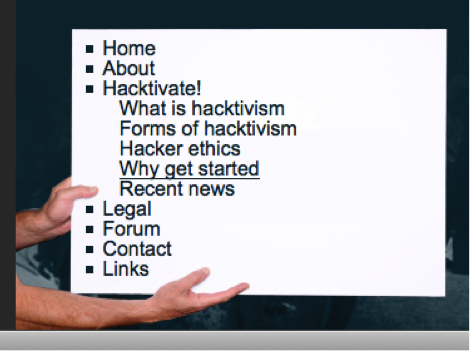#5 – Information Architecture / Content Analysis
Site map:
Content audit:
| Index | Page Title |
| 0.0.0 | Home |
| 1.0.0 | About |
| 2.0.0 | Hacktivate! |
| 2.1.0 | – What is hacktivism |
| 2.2.0 | – Forms of hacktivism |
| 2.3.0 | – Hacker ethics |
| 2.4.0 | – Why get started |
| 2.5.0 | – Recent news |
| 3.0.0 | Legal |
| 4.0.0 | Forum |
| 5.0.0 | Contact |
| 6.0.0 | Links |
| 7.0.0 | Disclaimer |
Information/content decisions:
Our home page welcomes readers and briefly informs first-time viewers of the website’s purpose. It also contains our social media feeds to keep viewers up to date, and a ‘recent news’ feed to make sure they’re informed about occurrences in the hacktivist world. As well as informing readers, it ensures our site looks up-to-date and in-the-know.
In the interests of informing and educating prospective cyber-activists, we included a page titled ‘hacktivate!’ as our primary informational medium. It includes 5 branches to sub-pages to do with explaining cyber-activism and invoking interest.
The legals page serves the purpose of informing users about the need to stay aware of the legal implications of their campaigns. Whilst guarding against this, it encourages users to utilise their rights as fully as possible.
The forum was included as an attempt at forging a sense of culture within the website. Through discussion users can identify with others with similiar motivations, as well as potentially exchanging useful information to eachother.
The ‘about’ page explicitly outlines our motivations. This is in order to give users a clear understanding of how they can benefit from using our website.
The ‘contact’ page allows users to contact us directly with concerns or queries, and the ‘links’ page offers a collection of resources deemed relevant and useful to the learning cyber-activist; complete with brief annotations.
Information architecture:
The website features a site map for easy navigation. It lists all of the website’s pages. Those below ‘Hacktivate’ are indented as we have classified them as sub-categories within the main Hacktivate category.
The links across the navigation bar are clearly separated. The links include the headings for those we have identified as our ‘main’ pages. The ‘hacktivate’ page contains the bulk of our content- i.e. the primary reason users view our website. Users will learn that to access this they either have to go through the ‘hacktivate’ tab on the nav bar, and then the list of sub-categories on that page, or in one click through the site map on the bottom of each page.
Additionally, we have included a Google search bar as a permanent feature on each page. Browsing our site, introductory-level cyber-activists may come across concepts they’re unfamiliar with; this feature allows them to remedy any uncertainties they encounter.
Each main category in the navigation bar is separated because it is a unique topic of information. The ‘hacktivate’ content page and the forum are crucial elements of the website’s identity; they carry out the site’s main function of educating prospective cyber-activists. The ‘legal’, ‘about’ and ‘link’ pages are supplementary information deemed relevant to users. Lastly, the ‘contact’ page is a mechanism for support; for users with additional demands. This classification system caters for the needs of users- cluttering the navigation bar with what are in essence sub-categories would confuse users, especially those new with the cyber-world (of which our target market is likely to include).
Reference:
Baird, C. 2012, Information Architecture for the Web, PowerPoint presentation, UTS, Sydney, < https://online.uts.edu.au/bbcswebdav/pid-795822-dt-content-rid-3891206_1/courses/58220/INFORMATION%20ARCHITECTURE.pdf>


Baird, K, 2012, Information Architecture for the Web, PowerPoint presentation, UTS, Sydney,